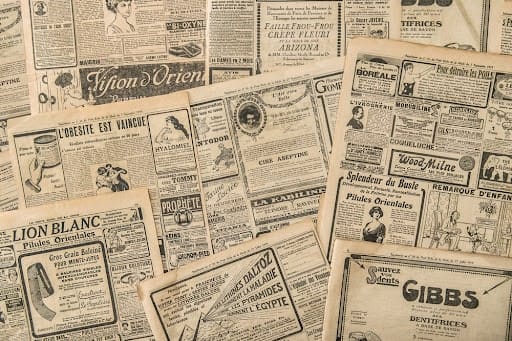The Future Of Print Advertising
By Drew Galvin on August 10, 2023

What does the future of print advertising look like in the digital age? While some may be quick to dismiss print media as outdated compared to digital advertising, experts actually say it is here to stay.
With the efficacy of direct mail, newsletters, billboards, and other forms of print media still holding firm against new waves of digital media, it’s clear that print advertising offers some unique benefits that digital ads lack.
In this blog, we’ll examine the history of print advertising, its current effectiveness, print vs. digital advertising, and what the future of print advertising really looks like.
History Of Print Advertising
Print advertising actually dates back to ancient civilizations. One of the earliest discoveries of print advertising comes from Thebes in Egypt with a papyrus fragment from around 3000 BC.
However, in 1436, the invention of the printing press transformed print media as we know it. Global literacy rates increased dramatically. Print advertising’s first major boom also aligned with the Industrial Revolution, owing largely to the mass production of newspapers and magazines.
In 1836, French journalist and politician Émile de Girardin created Las Presse, the first newspaper to subsidize the cost of printing by using advertising. Girardin found that advertising made printing newspapers more affordable, which ultimately led to the development of more newspapers. As a result, public access to newspapers grew significantly.

5 years later, in 1841, the first advertising agency was created in the U.S. By the 20th century, print advertising saw its most dramatic growth and its most dramatic competition.
Radio advertising began competing with print in 1920. Radio provided advertisers with the ability to mass market quickly to the whole country. Print advertising, though, provided a main competitive advantage: visual imagery. As a result, the use of images in print advertising began playing a larger role.
The first TV advertisement aired in 1941, challenging print advertising once again. To be competitive with, and excel over the predominantly black-and-white TV ads, print began doubling down on the use of imagery, particularly color imagery.
The golden age of advertising is often referred to as the period from the 1960s to the 1980s. Print advertisements became more creative and daring in their use of space, color, and abstract concepts.
The 80s and 90s shifted to a more minimalist style of advertising that we commonly associate with ads today. Internet advertising began in 1994 when a digital banner ad was launched by the online magazine Hotwired.
With the advent of smartphones and social media, print advertising now complements and coexists with the larger digital marketing campaigns of the 21st century. Though print advertising budgets continue to decline for most newspapers and magazines, the effectiveness of print advertising should not be understated, particularly in the direct mail space.
There is something tangible and purposeful about holding a piece of print media in your hand rather than scrolling past it on a screen. Finding a personalized letter or postcard in your mailbox makes more of a lasting impression than an email notification. We also tend to trust traditional media more than social media, and engage with printed advertisements at higher rates than digital ads.
Direct mail also presents new, exciting opportunities for grabbing audiences’ attention and generating higher response rates than digital ads. The print vs. digital debate may never reach a verdict, but it does generate some interesting questions: what is print advertising? And why is it still effective?

Types Of Print Advertising
Definitions of print advertising are broad. Print advertising generally includes newspapers, newsletters, magazines, billboards, posters, letters, postcards, mailers, business cards, and more.
Different types of print media target consumers at different parts of the marketing funnel.
Billboard advertisements, for example, are an effective medium to enhance recall and consideration. Direct mail, which includes letters, postcards, brochures, and mailers, is often used to capture new leads at the top of the marketing funnel.
With those basic definitions down, let’s get into the efficacy of print advertising today.
Is Print Advertising Still Effective?
Print media can be a valuable asset to a business’ overall marketing strategy, especially when paired with digital media.
Print advertising, interestingly enough, is the most trusted form of advertising among American consumers—more than social media and digital ads. Almost half of American consumers in a 2021 survey shared that they trusted print ads, while less than 1 in 5 of these same consumers said that they trusted social media ads.
Response rates for direct mail have also been increasing in recent years, and direct mail boasts the highest response rate of all the direct marketing channels.
On average, oversized envelopes have a household response rate of 6.6%, with postcards at 5.7% and letter-sized envelopes at 4.3%. In contrast, the average email marketing response rate is .6%, and the average social media ad response rate is .4%.
In other words, a prospect is 16 times more likely to respond to an oversized envelope mailer than a social post.
Print vs. Digital Advertising
As we have mentioned, there is an endless debate over which form of advertising is superior. A more nuanced side to the debate suggests both forms of advertising working in tandem is the answer, rather than painting print and digital as mutually exclusive. With that said, each form definitely has its strong suits. We’re breaking down some of the pros and cons of each below.
Pros of print advertising over digital:
- Engagement is considered one of print media’s greatest strengths. Print ads in magazines make one pause, feel, and consider a product, rather than just scroll past it. Physical letters and postcards convey a thoughtfulness that email just lacks.
- As we mentioned, print advertising generally instills more trust in consumers than digital advertising. Newspapers report 58% more trust compared to any other form of media, and trust for online media only reaches 27%.
Pros of digital advertising over print:
- Digital ads tend to have shorter lead times than print ads. Print ads must go through production and distribution phases, unlike social ads. Writing, printing, and collecting feedback for print ads simply necessitates longer lead times.
- Digital ads also tend to be less costly to have included in a publication. For example, a ⅛ page ad in The Washington Post costs about $20,000. The average cost of a 1-page ad in a local newspaper is about $1,000. However, the cost to post a digital ad for a local online newspaper can be as little as $50. Additionally, print newspaper circulation has declined drastically in the last two decades, while digital circulation increases year after year.
The Future Of Print Advertising
Despite the public trust in print advertising, the medium has been on a decline since around the turn of the century. In 2000, spending on advertising in newspapers peaked at around $68 billion annually. In 2016, that number had dropped to $18.3 billion. Still, direct mail advertising spend continues to increase year after year, and direct mail’s average response rates follow suit.
Social media has been cited as a significant cause of the decline of print media in the past decade. It seems at least for now, a hybrid model allows digital and print advertising to coexist and complement each other. Businesses can target online and offline audiences by doing both.

Silver Linings
It’s clear that print advertising is a resilient and adaptable medium. It has survived the advent of radio, TV, and digital (internet/social) advertising so far, and experts say it isn’t going anywhere yet.
Print advertising boasts higher trust from consumers than digital advertising and stronger emotional responses from consumers in studies. Tactics like direct mail also receive high response rates, making it one of the most viable forms of print advertising in 2023.
How Safeguard by Innovative Can Help
Safeguard by Innovative’s 30+ years of business experience and award-winning history make us the leading experts in the direct mail and commercial printing service spaces.
We understand the importance of a hybrid model in which businesses utilize both print and digital advertising to reach online and offline audiences.
If you have questions about direct mail, questions about partnering with a commercial printing company, need help deciding what types of commercial printing are right for your business, or are wondering how you can incorporate print into your digital marketing strategy, our team of experts is here to support you, offer guidance, and help you find the right print advertising strategy for your business’ goals and budget.





